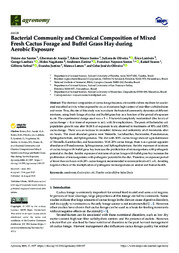Bacterial community and chemical composition of mixed fresh cactus forage and buffel grass hay during aerobic exposure.
Bacterial community and chemical composition of mixed fresh cactus forage and buffel grass hay during aerobic exposure.
Autoria: SANTOS, D, dos; ARAUJO, G. G. L. de; SANTOS, E. M.; OLIVEIRA, J. de; LAMBAIS, E.; LAMBAIS, G.; NAGAHAMA, H.; ZANINE, A.; SANTOS, F. N.; SOARES, R.; SOBRAL, G.; JUSTINO, E.; LEMOS, M.; OLIVEIRA, C. J. de
Resumo: The chemical composition of cactus forage becomes a favorable culture medium for accelerated microbial activity when exposed to air, as it contains high content of non-fiber carbohydratesand water. Thus, the aim of this study was to evaluate the bacterial community dynamics of different mixtures, using fresh forage of cactus and buffel grass hay as a function of the period of exposure to air. The experimental design used was a 5 × 5 factorial completely randomized (five levels of cactus forage × five times of exposure to air), with five replications. The peak of Escherichia coli population growth was after 16.06 h of exposure to air, observed in treatments of 90% and 100% cactus forage. There was an increase in microbial richness and uniformity of all treatments after six hours. The most abundant genera were Weissella, Lactobacillus, Bacteroides, Pseudomonas, Sphingobacterium, and Sphingomonas. The diet with 100% cactus forage showed a predominance of Weissella, Lactobacillus, and Leuconostoc. With 20% cactus forage, there was a greater apparent abundance of Pseudomonas, Sphingomonas, and Sphingobacterium. Aerobic exposure of mixtures of cactus forage with buffel grass hay increases the proliferation of microorganisms with pathogenic potential in the diet. Aerobic exposure of mixtures of cactus forage with buffel grass hay increases the proliferation of microorganisms with pathogenic potential in the diet. Therefore, an exposure period of fewer than six hours with 20% cactus forage is recommended to minimize levels of E. coli. Avoiding negative effects of the multiplication of pathogenic microorganisms on animal and human health
Ano de publicação: 2022
Tipo de publicação: Artigo de periódico
Unidade: Embrapa Semiárido
Observações
1 - Por padrão são exibidas publicações dos últimos 20 anos. Para encontrar publicações mais antigas, configure o filtro ano de publicação, colocando o ano a partir do qual você deseja encontrar publicações. O filtro está na coluna da esquerda na busca acima.
2 - Para ler algumas publicações da Embrapa (apenas as que estão em formato ePub), é necessário ter, no celular ou computador, um desses softwares gratuitos. Sistemas Android: Google Play Livros; IOS: iBooks; Windows e Linux: software Calibre.
Acesse outras publicações
Acesse a Base de Dados da Pesquisa Agropecuária (BDPA) para consultar o acervo completo das bibliotecas da Embrapa.

